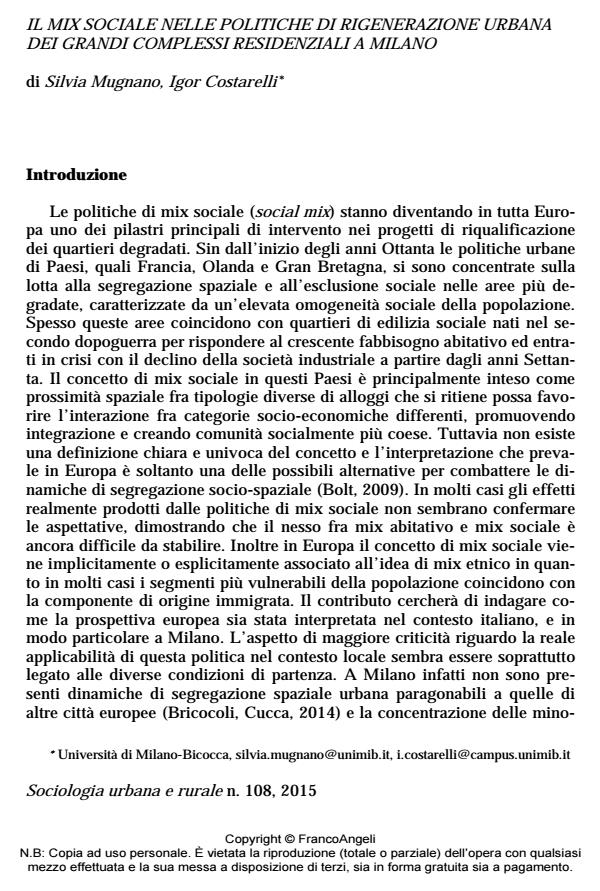Is Social Mix Re-Shaping Regeneration Policies in Large Housing Estates in Milan?
Journal title SOCIOLOGIA URBANA E RURALE
Author/s Silvia Mugnano, Igor Costarelli
Publishing Year 2016 Issue 2015/108 Language Italian
Pages 15 P. 86-100 File size 63 KB
DOI 10.3280/SUR2015-108006
DOI is like a bar code for intellectual property: to have more infomation
click here
Below, you can see the article first page
If you want to buy this article in PDF format, you can do it, following the instructions to buy download credits

FrancoAngeli is member of Publishers International Linking Association, Inc (PILA), a not-for-profit association which run the CrossRef service enabling links to and from online scholarly content.
The article aims to compare Italy with other European countries (such as France, the Netherlands and the UK) on the current debate on social mix policies which is locally mainly interpreted as mixed housing tenures. The paper points out that in Lombardy -and specifically in Milan- proximity in itself does not imply any social cohesion and public actions put in place are sometimes still unclear, too weak and fragile. However, some local experiences in social housing estates based on community empowerment can trigger social innovation in this field.
Keywords: Social mix, Housing, Milan, Community empowerment, Large housing estates, Social innovation
- Agustoni A., Alietti A., Cucca R. (2015). Neoliberismo, migrazioni e segregazione spaziale. Politiche abitative e mix sociale nei casi europeo e italiano. Sociologia urbana e rurale, 106: 118-136. DOI: 10.3280/SUR2015-10600
- Bertocchi P. (2006). Mazzini. Il quartiere si ritrova in città. In Cella M. (a cura di). Un Contratto per La Città. I Contratti Di Quartiere II a Milano. Monfalcone: EdicomEdizioni.
- Blanc M. (2010). The Impact of Social Mix Policies in France. Housing Studies, 2: 257-72. DOI: 10.1080/0267303090356292
- Bolt G. (2009). Combating Residential Segregation of Ethnic Minorities in European Cities. Journal of Housing and the Built Environment, 24: 397-405. DOI: 10.1007/s10901-009-9163-
- Briata P. (2012). Beyond Social Mix: Looking for a Path to Rethink at Planning in the ‘cities of Difference’. Plurimondi, 5, 10: 65-80.
- Bricocoli M., Cucca R. (2014). Social mix and housing policy: Local effects of a misleading rhetoric. The case of Milan. Urban Studies, 1-15. DOI: 10.1177/004209801456049
- CAS -Centre d’Analyse Stratégique- (2011). Des ‘effets de Quartier’ À La Politique de La Ville. Perspectives Internationales. La Note d’Analyse.
- Chaline C. (2011). Les politiques de la ville. Paris: Presses universitaires de France, 7ème édition.
- Colomb C. (2007). Unpacking New Labour’s ‘Urban Renaissance’ Agenda: Towards a Socially Sustainable Reurbanization of British Cities? Planning Practice and Research, 1: 1-24. DOI: 10.1080/0269745070145524
- Department for Communities and Local Government (2012). National Planning Policy Framework. https://www.gov.uk/government/uploads/system/uploads/attachment_data/file/6077/2116950.pdf. Ultima consultazione online il 12 settembre 2015.
- Donzelot J. (2006). Quand la ville se défait: quelle politique face à la crise des banlieues? Paris: Seuil.
- Fioretti C. (2010). Immigration and Territories: Looking beyond Social Cohesion Rhetoric. Journal of Landscape Studies 3, 97-104.
- Fioretti C. (2012). La mixité in Italia: soluzione o problema? Lo Squaderno, 25: 51-55.
- Golinelli M. (2008). Le tre case degli immigrati. Dall’integrazione incoerente all’abitare. Milano: FrancoAngeli.
- Kirszbaum T. (2008). Rénovation urbaine, une mixité très peu sociale. Projet, 307, 6: 30-37. DOI: 10.3917/pro.307.003
- Lelévrier C. (2010). La Mixité Dans La Rénovation Urbaine: Dispersion Ou Re-Concentration? Espaces et Sociétés, 140-141: 59-74. DOI: 10.3917/esp.140.005
- Lelévrier C. (2013a). Forced relocation in France: how residential trajectories affect individual experiences. Housing Studies, 2: 253-71. DOI: 10.1080/02673037.2013.767883
- Lelévrier C. (2013b). Au nom de la «mixité sociale». Savoir/Agir, 3: 11–17.
- Mugnano S. (2008). Milano tra luci e ombre. In Mugnano S., Zajczyk F. (a cura di). Ripensare Milano guardando all’Europa. Pratiche di riqualificazione urbana. Milano: Cortina.
- Mugnano S., Palvarini P. (2013a). Ripensare la questione abitativa degli stranieri: le sfide del mix sociale. In Boatti A. (a cura di). Abitare in Lombardia ai tempi della crisi. Dimensioni, tendenze e criticità della questione abitativa. Santarcangelo di Romagna: Maggioli.
- Mugnano S., Palvarini P. (2013b). ‘Sharing Space without Hanging Together’: A Case Study of Social Mix Policy in Milan. J. Cities. DOI: 10.1016/j.cities.2013.03.008
- Musterd S., Andersson R. (2005). Housing Mix, Social Mix, and Social Opportunities. Urban Affairs Review, 6: 761-90. DOI: 10.1177/107808740527600
- Olagnero M., Ballor F. (2010). Convivenza e cooperazione sociale in contesti urbani: il caso degli ex Villaggi Olimpici a Torino. Rassegna italiana di sociologia, 3: 429-458. DOI: 10.1423/3294
- Orim (a cura di). (2011). Decimo rapporto sugli immigrati in Lombardia. Anno 2010. Milano: Fondazione Ismu.
- Orim (a cura di). (2012). Rapporto 2011. Gli immigrati in Lombardia. Milano: Fondazione Ismu.
- Valli C. (2009). Modelli di segregazione. Concentrazione fisica e esclusione sociale in due quartieri multietnici di Milano e Stoccolma. Tesi di laurea specialistica in Pianificazione Urbana e Politiche Territoriali, Politecnico di Milano.
- Van Gent W.P.C., Musterd S., Ostendorf W. (2009). Disentangling Neighbourhood Problems: Area-Based Interventions in Western European Cities. Urban Research & Practice, 2, 1: 53-67. DOI: 10.1080/17535060902727066
- Van Kempen R., Bolt G. (2009). Social cohesion, social mix, and urban policies in the Netherlands. Journal of Housing and the Built Environment, 4: 457-475. DOI: 10.1007/s109010099161
- Zajczyk F., a cura di (2003). La povertà a Milano. Distribuzione territoriale, servizi sociali e problema abitativo. Milano: FrancoAngeli.
- Rethinking urban utopianism: The fallacy of social mix in the 15-minute city Giada Casarin, Julie MacLeavy, David Manley, in Urban Studies /2023 pp.3167
DOI: 10.1177/00420980231169174 - L'importazione delle politiche di mix sociale nel contesto italiano: il caso di Bergamo Emanuele Belotti, in ARCHIVIO DI STUDI URBANI E REGIONALI 122/2018 pp.10
DOI: 10.3280/ASUR2018-122002
Silvia Mugnano, Igor Costarelli, Il mix sociale nelle politiche di rigenerazione urbana dei grandi complessi residenziali a Milano in "SOCIOLOGIA URBANA E RURALE" 108/2015, pp 86-100, DOI: 10.3280/SUR2015-108006